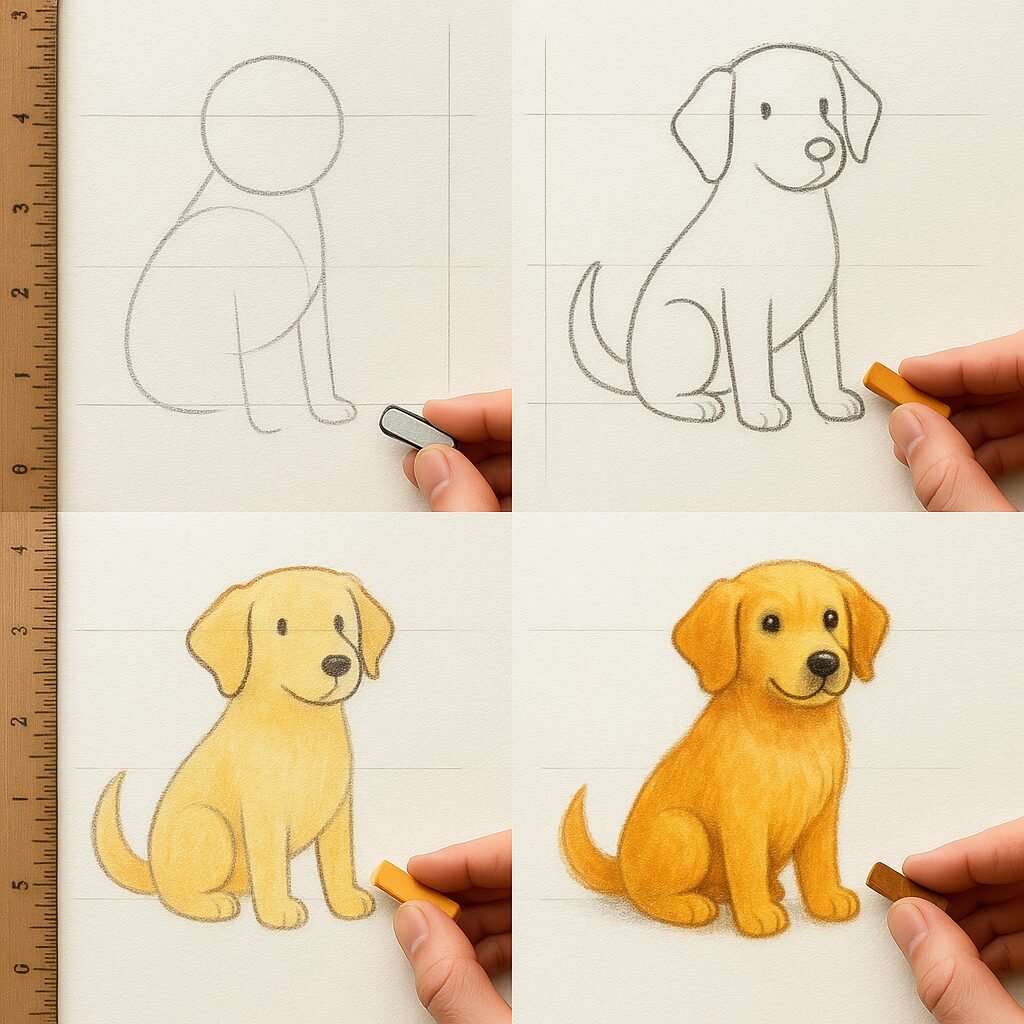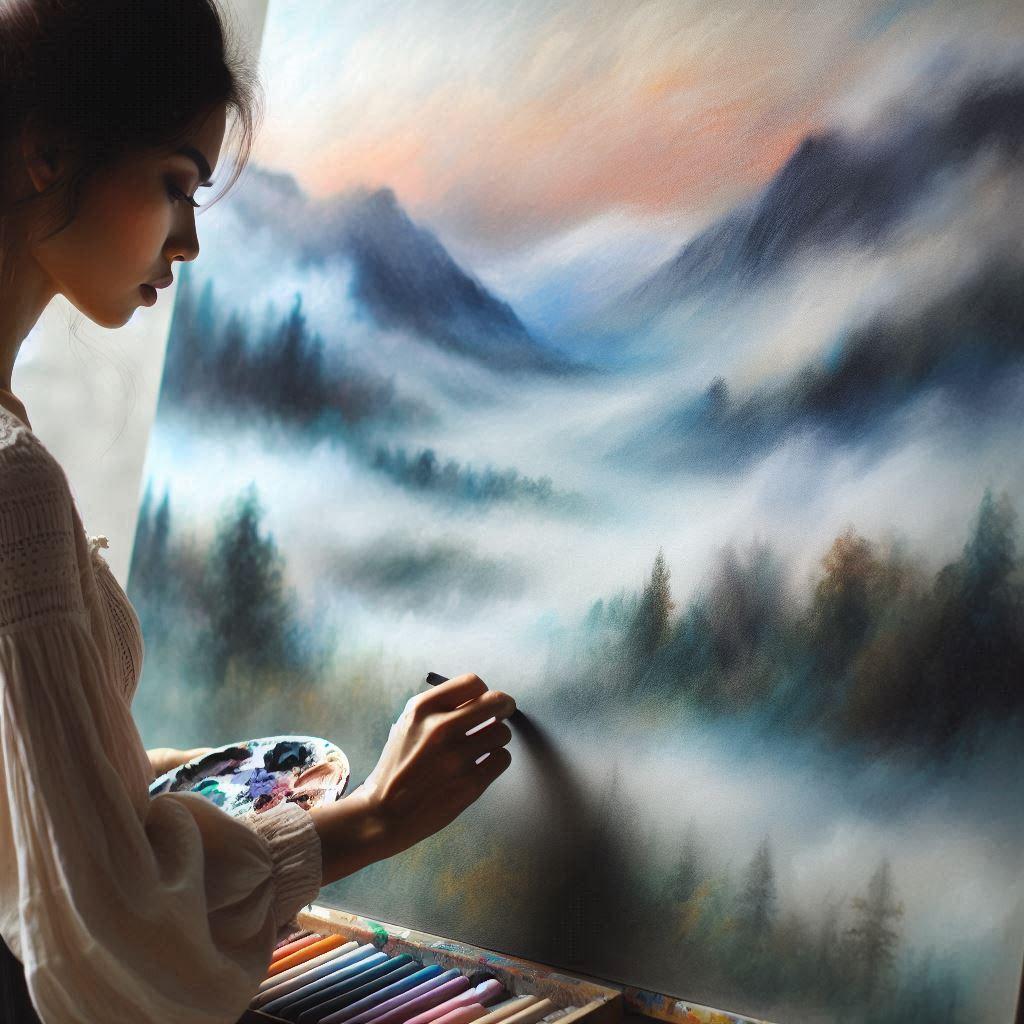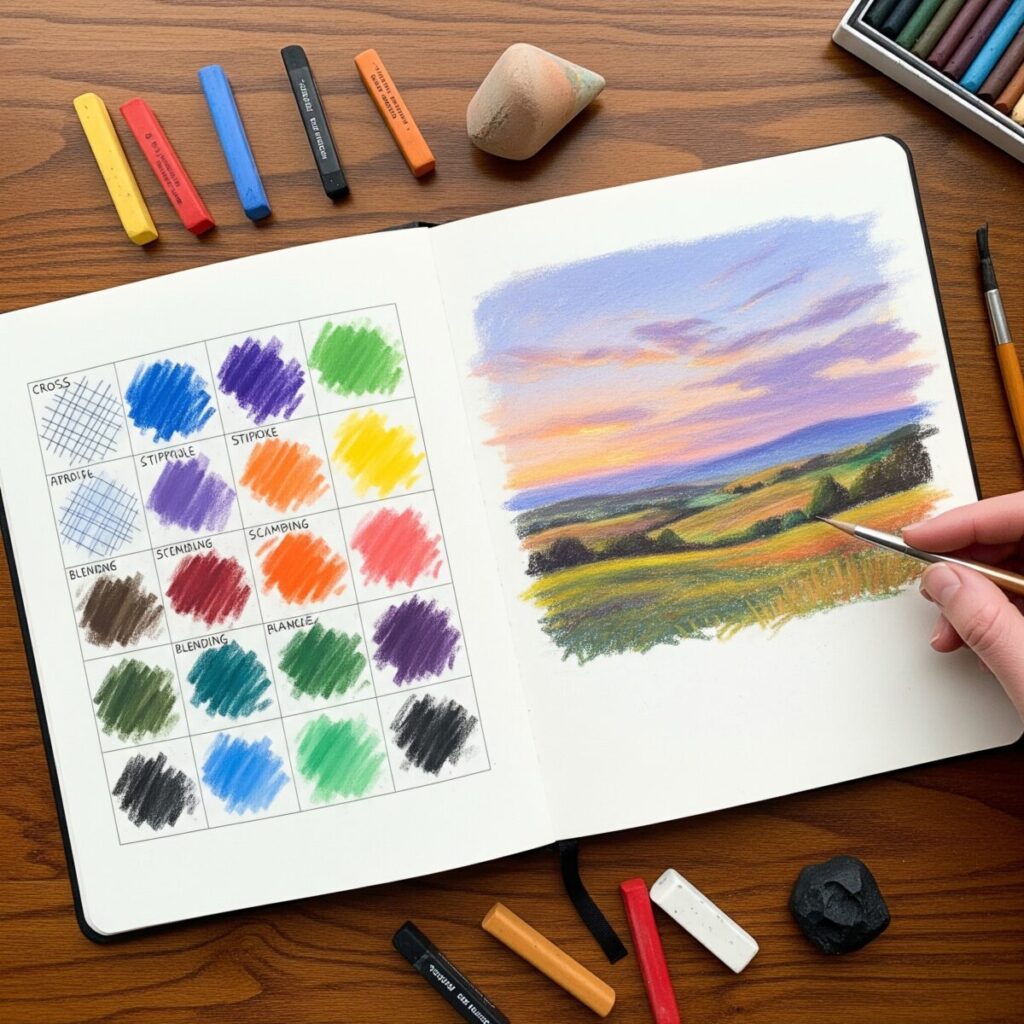Starting your artistic journey with easy animal drawings opens up a world of creative possibilities that’s both fun and rewarding. Animals make perfect subjects for beginners because they’re forgiving, emotionally engaging, and offer endless variety in shapes, textures, and colors. When you combine simple animal subjects with the soft, blendable nature of pastels, you create the ideal learning environment for developing your artistic skills. Whether you’re drawn to fluffy cats, loyal dogs, or graceful birds, these subjects will help you master basic techniques while creating artwork you’ll be proud to display.
Key Points Summary
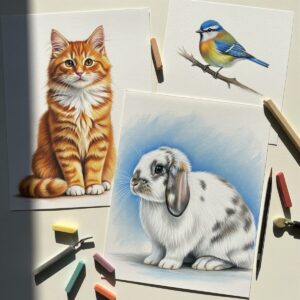
- Animals are ideal first subjects due to their forgiving proportions and emotional appeal
- Pastels offer beginner-friendly blending and layering techniques perfect for animal textures
- Eight specific animals provide excellent starting points for new artists
- Basic supplies and simple techniques can produce impressive results
- Step-by-step approach builds confidence and skills progressively
Why Animals Make Perfect First Drawing Subjects
Animals connect with us on an emotional level, making them naturally engaging subjects that keep you motivated throughout the creative process. Unlike complex landscapes or detailed portraits, animal drawings allow for creative interpretation without strict rules about perfect accuracy. A slightly wonky ear or an oversized paw often adds character rather than detracting from the artwork.
The beauty of animal subjects lies in their variety of basic shapes. Most animals can be broken down into simple circles, ovals, and triangles, making them excellent for learning fundamental drawing skills. This approach helps you understand essential elements of composition while building confidence with each successful sketch.
Animals also offer incredible diversity in textures and patterns, from smooth fish scales to fluffy rabbit fur. This variety helps you practice different pastel techniques without feeling overwhelmed by complex subject matter. Plus, animals are naturally forgiving subjects – slight imperfections often enhance their charm rather than ruining the drawing.
Essential Pastel Supplies for Animal Drawing
Getting started with pastel animal drawings doesn’t require an expensive setup. Here’s what you need to create beautiful artwork:
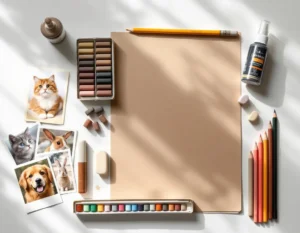
Basic Soft Pastel Set
- Start with a 24-48 color set including earth tones (browns, grays, beiges)
- Include basic colors like white, black, and primary colors
- Look for reputable brands like Faber-Castell or Rembrandt for quality results
Paper Selection
- Choose textured pastel paper or sanded paper for better color adhesion
- Neutral tones (gray, tan, or cream) work well for most animal subjects
- 9×12 inches provides ample space without being overwhelming
Essential Tools
- Blending stumps in various sizes for smooth color transitions
- Kneaded eraser for corrections and highlights
- Fixative spray to preserve your finished artwork
- Paper towels or tissues for quick blending
Consider exploring our comprehensive guide on painting supplies for artists for more detailed information about art materials.
Top 8 Easy Animals for Pastel Beginners
1. Cats – Perfect Circular Shapes
Cats offer ideal starting points with their round heads, oval bodies, and triangular ears. Their fluffy fur is forgiving with pastels, and slight proportional mistakes often add to their appeal. Start with a simple sitting cat pose, focusing on the basic head and body shapes before adding details like whiskers and facial features.
2. Dogs – Variety and Expression
Dogs provide endless variety in breeds and expressions, making them excellent practice subjects. Golden retrievers and labradors have simple, friendly shapes that are perfect for beginners. Their expressive eyes and soft fur textures work beautifully with pastel blending techniques.
3. Rabbits – Soft Textures
Rabbits excel at teaching texture techniques with their distinctive fluffy fur. Their simple oval bodies and long ears create pleasing compositions, while their gentle nature makes them emotionally appealing subjects. Practice creating soft, downy textures that pastels handle exceptionally well.
4. Birds – Basic Forms and Colors
Simple birds like robins or cardinals offer opportunities to practice both form and color work. Their streamlined shapes are easy to construct from basic ovals, and their bright plumage provides excellent color mixing practice. Start with side-view poses for simplicity.
5. Fish – Flowing Forms
Fish provide excellent practice for smooth, flowing lines and scale textures. Goldfish are particularly beginner-friendly with their simple shapes and bright colors. Their fins offer great opportunities to practice directional strokes and movement in your artwork.
6. Butterflies – Symmetry and Pattern
While insects might seem complex, butterflies are surprisingly approachable. Their symmetrical wings teach balance and pattern work, while their bright colors showcase pastel’s vibrant possibilities. Start with simple monarch or swallowtail butterfly designs.
7. Farm Animals – Simple Shapes
Cows, pigs, and sheep offer wonderfully simple forms perfect for beginners. Their basic geometric shapes and gentle expressions make them approachable subjects. These animals also provide excellent practice for creating different fur and skin textures.
8. Pandas – High Contrast Practice
Pandas are ideal for learning contrast and value relationships. Their distinctive black and white markings teach you about light and shadow while their round, cuddly shapes remain beginner-friendly. They’re also incredibly popular subjects that always generate positive reactions.
Basic Techniques for Animal Features
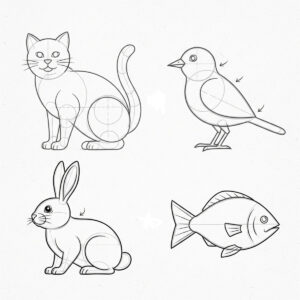
Creating Expressive Eyes Eyes are often the focal point of any animal drawing. Start with basic shapes – circles or ovals – then add pupils and highlights. Use darker pastels for pupils and leave small white spots for light reflections. Blend softly around the eye area to create natural-looking eye sockets.
“The eyes are the windows to the soul, even in animal art. Get the eyes right, and your entire drawing comes to life.”
Mastering Fur and Texture Different animals require different texture approaches. For short fur like cats, use short, directional strokes following the fur’s natural growth pattern. For longer fur like rabbits, use longer, sweeping motions. Layer different colors to create depth and natural variation in fur tones.
Understanding Proportions Most animals follow predictable proportional relationships. A cat’s head typically fits into its body about 2-3 times, while a dog’s proportions vary by breed. Don’t worry about perfect accuracy – focus on creating pleasing, believable proportions that capture the animal’s essential character.
Effective Shading Techniques Animals have natural light and shadow patterns that help define their three-dimensional form. Observe how light hits rounded forms like heads and bodies. Use lighter pastels for highlighted areas and gradually blend to darker tones in shadowed regions. This creates the illusion of form and volume.
Learn more about fundamental techniques in our guide to painting techniques for beginners.
Step-by-Step: Drawing Your First Pastel Animal

Let’s walk through creating a simple cat drawing that showcases fundamental pastel techniques:
Step 1: Basic Construction Start with light guidelines using a hard pastel or pastel pencil. Draw a large circle for the head and an oval for the body. Add triangular ears and basic leg shapes. Keep these initial marks light and loose.
Step 2: Refining the Outline Gradually refine your basic shapes into more cat-like forms. Round out the head, add facial feature guidelines, and adjust the body proportions. This stage focuses on getting the overall shape and pose correct before adding any color.
Step 3: Base Colors Apply your base colors using the side of your pastel stick for broad coverage. For an orange tabby, start with light orange or peach tones. Don’t worry about details yet – focus on establishing the overall color scheme and major color areas.
Step 4: Building Form with Value Add darker tones to create shadows and form. Observe how light hits a rounded cat head – typically lighter on top and darker underneath. Use your blending stumps to create smooth transitions between light and dark areas.
Step 5: Details and Finishing Add final details like eyes, nose, whiskers, and fur texture. Use sharp pastel edges for precise details and blend selectively to maintain some crisp edges. Apply fixative in light coats to preserve your finished artwork.
This systematic approach works for any animal subject and builds your skills progressively. Check out our 7 principles of painting for beginners for additional foundational concepts.
Common Beginner Mistakes and How to Avoid Them
Overcomplicating the Subject Many beginners choose overly complex poses or detailed breeds for their first attempts. Start simple with basic poses and common animals before attempting challenging subjects like horses in motion or detailed bird feathers.
Poor Proportional Relationships Rushing through the initial construction phase often leads to proportional problems that become difficult to fix later. Spend adequate time on your basic shapes and guidelines – this foundation determines your drawing’s success.
Muddy Colors from Over-blending While pastels blend beautifully, excessive blending can create muddy, lifeless colors. Preserve some areas of pure color and blend selectively for the most vibrant results. Sometimes a few distinct strokes are more effective than perfectly smooth blending.
Building Your Skills Progressively
Start with the simplest subjects and gradually work toward more complex animals as your confidence grows. Consider creating a series of easy animal drawings to practice different techniques and build a portfolio of work.
Document your progress with photos and notes about what techniques worked well. This reflection helps identify areas for improvement and celebrates your artistic growth. Many artists find that keeping a creative sketchbook helps maintain momentum and inspiration.
Inspiring Pastel Artists
| Artist Name | Period/Style | Notable for… | Why they’re inspiring for pastel art |
|---|---|---|---|
| Edgar Degas | Impressionism | His extensive use of pastel to capture dancers, bathers, and everyday life with dynamic composition and light. | He pushed the boundaries of pastel, layering and blending to achieve luminous effects and a sense of movement. His experimentation with the medium is highly influential. |
| Mary Cassatt | Impressionism | Her tender and intimate portraits of mothers and children, often rendered in soft yet vibrant pastels. | Cassatt mastered the expressive potential of pastel, using it to convey emotion and form with great sensitivity. Her rich colors and confident strokes are a masterclass. |
| Rosalba Carriera | Rococo | A pioneering 18th-century portrait painter who popularized pastel as a serious art medium. | Carriera’s delicate and refined pastel portraits demonstrated the medium’s ability to achieve subtle gradations of color and realistic textures, elevating its status. |
| Odilon Redon | Symbolism | His dreamy, often mystical works that explored the subconscious and fantastical imagery, transitioning from dark charcoal to vibrant pastels. | Redon’s embrace of color in his later pastel works showed the medium’s capacity for evocative and ethereal effects, moving beyond mere drawing to full-fledged painting. |
| Wolf Kahn | Contemporary Landscape | His vibrant and colorful landscape paintings, often incorporating bold oil pastels to create luminous effects. | Kahn’s use of intense color and simplified forms in pastel landscapes is incredibly dynamic and inspiring for artists looking to explore color and light in a painterly way. |
| Sally Strand | Contemporary Realism | Her exquisite figurative works and portraits, known for their masterful handling of light and shadow in pastel. | Strand’s attention to detail and ability to capture the nuance of light on surfaces makes her work a fantastic resource for learning about realistic rendering in pastel. |
| Duane Wakeham | Contemporary Landscape | His expressive and atmospheric landscapes, often depicting sweeping vistas and dramatic skies in pastel. | Wakeham’s use of rich textures and bold strokes in pastel landscapes demonstrates the medium’s ability to create powerful and immersive scenes. |
| Nancie King Mertz | Contemporary Cityscapes/Landscape | Her vivid cityscapes and landscapes, known for their energetic marks and ability to capture the essence of a place. | Mertz’s confident and direct approach to pastel, often working alla prima, is inspiring for artists seeking spontaneity and strong compositional impact. |
| Tony Allain | Contemporary Landscape | His vibrant and impressionistic landscapes, often characterized by strong light and bold, broken color in pastel. | Allain’s work exemplifies how pastel can be used to capture the fleeting moments of light and atmosphere with remarkable freshness and energy. |
| Emma Colbert | Contemporary Animal Portraits | Her lifelike and expressive animal portraits, showcasing intricate fur textures and capturing the personality of her subjects in pastel. | Colbert’s dedication to animal subjects and her skill in rendering fine details with soft pastels offer great inspiration for those interested in realistic animal art. |
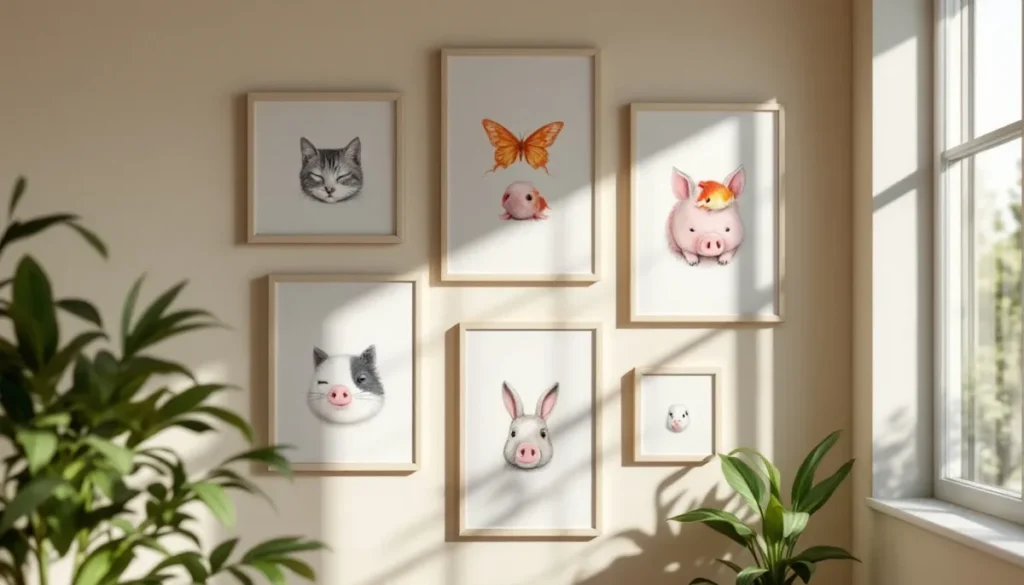
Frequently Asked Questions
What are the easiest animals to draw for beginners? Cats, dogs, rabbits, and birds are ideal starting points because they have simple, forgiving shapes and familiar features. These animals can be broken down into basic geometric forms, making them perfect for learning fundamental drawing skills.
How do you start drawing animals with pastels? Begin with basic shapes using light guidelines, then gradually refine the forms before adding color. Start with simple poses and familiar animals, focusing on overall proportions before adding details like fur texture or facial features.
What supplies do I need for pastel animal drawings? You’ll need a basic soft pastel set (24-48 colors), textured pastel paper, blending stumps, a kneaded eraser, and fixative spray. This basic kit provides everything necessary to create beautiful animal artwork without a large investment.
How do you draw realistic animal fur with pastels? Use directional strokes that follow the fur’s natural growth pattern. Layer different colors to create depth and natural variation. Short strokes work for cats and dogs, while longer strokes suit animals with flowing fur like horses or rabbits.
What are the best pastel colors for animal drawings? Earth tones (browns, grays, beiges) form the foundation of most animal drawings. Include basic colors like white, black, and primary colors for eyes, noses, and colorful subjects like birds or fish.
How long does it take to learn animal drawing? Basic animal drawings can be achieved in your first session, but developing strong skills takes consistent practice over several months. Focus on one animal type at a time and practice regularly for steady improvement.
Conclusion
Easy animal drawings provide the perfect introduction to pastel art, combining approachable subjects with forgiving techniques that build confidence and skills simultaneously. By starting with simple animals like cats, dogs, and rabbits, you’ll master fundamental concepts while creating artwork that connects emotionally with viewers. The key to success lies in choosing appropriate subjects, using quality materials, and practicing regularly with patience and enthusiasm.
Remember that every professional artist started with simple subjects and basic techniques. Your easy animal drawings represent the beginning of an exciting artistic journey that can lead to increasingly sophisticated artwork over time. Embrace the learning process, celebrate small victories, and most importantly, enjoy the creative satisfaction that comes from bringing these beloved creatures to life through your art.
For more inspiration and techniques, explore our comprehensive guides on watercolor animal painting and discover additional easy painting ideas to expand your artistic horizons.

